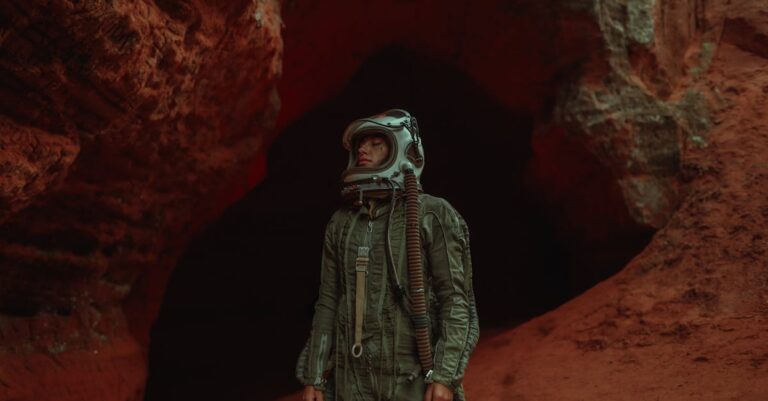
## The Static Between Stars
The chipped Formica counter felt cold under Anya’s elbows. Rain lashed against the diner window, blurring the neon glow of “Rosie’s” into watery streaks. She traced patterns on her lukewarm coffee cup, ignoring Earl the short-order cook’s pointed stare. Three days since the last anomaly. A lifetime in her line of work.
She’d seen patterns, alright. Not the comforting kind. Constellations weren’t fixed anymore. Not entirely. Cassiopeia had *shifted*. A slight rotation, barely perceptible to the untrained eye, but enough. Enough to send a chill crawling up her spine.
“Another refill?” Earl grunted, the question more statement than inquiry.
Anya shook her head. “Just the check.” She needed to get back to the observatory, sift through the data again. This wasn’t a glitch. Not like the solar flares last spring. This felt… intentional.
The image swam in her mind: a map of extinct predator territories overlaid with the altered star charts. Saber-tooth tiger range aligning with a newly displaced cluster in Orion’s Belt. Dire wolf hunting grounds echoing the subtle re-arrangement of stars near Ursa Minor. It was insane. Astronomical impossibility layered with ecological ghost stories.
She paid, leaving a generous tip despite the gnawing anxiety tightening her chest. Outside, the rain had eased into a persistent drizzle. Anya pulled her collar tighter and headed for her truck, an aging Ford Ranger whose best days were far behind it. The observatory sat perched on the highest ridge overlooking the valley, a lonely sentinel against the vast darkness.
—
The dome groaned as it rotated, exposing the massive telescope to the bruised sky. Anya ran diagnostics, confirming the instrument’s functionality. Everything was nominal. But she already knew that wasn’t the problem.
“Show me Cassiopeia,” she murmured, inputting the coordinates. The telescope whirred, adjusting its focus. On the screen, the familiar W-shaped constellation swam into view. Then she overlaid it with the historical data, comparing it to images from decades past. The difference was subtle, but undeniable. A slight clockwise rotation, as if the stars themselves had… recoiled.
“Damn it.”
She pulled up the ecological data, cross-referencing predator populations. The saber-tooth decline mirrored a similar shift in star formation near the Pleiades cluster. A pattern emerged, cold and precise.
“It’s not random,” she breathed, her fingers flying across the keyboard. “They’re mimicking abandonment timelines.”
—
Liam traced the floral pattern on the sterile wall of his solarium. Pale blue hydrangeas, digitally rendered to bloom eternally. He hated them. Too… predictable. His skin prickled with a familiar warmth, then shifted into a pulsating violet. He’d been staring at the sunset simulation for too long. Too much orange, too much vibrancy.
“Another adjustment needed,” the automated voice intoned from the speaker above his head. “Emotional baseline exceeding optimal parameters.”
He pressed a button, dimming the simulation to grayscale. The violet faded slightly, replaced by a sickly teal. He’d learned to control it, mostly. Mask the outbursts. Appear functional. But it was exhausting.
His ChromaKey skin responded to visual dominance. Intense colors triggered a spectral reconfiguration, broadcasting his emotional state for anyone connected to the network to see. Public avoidance wasn’t a choice; it was self-preservation. A kaleidoscope of uncontrolled emotion invited scrutiny, judgment, and ultimately, isolation.
He’d been assigned a behavioral specialist, Dr. Aris Thorne, who insisted on ‘conditioning exercises.’ Repetitive exposure to neutral stimuli. Bland landscapes. Monochromatic designs. They hadn’t worked.
The door hissed open, and Thorne entered, radiating an unsettling calm. She held a tablet, her expression unreadable.
“Liam,” she said, her voice smooth as polished stone. “We’ve been monitoring your response to the sunset simulation. It appears you’re still experiencing fluctuations.”
“It’s too bright,” Liam mumbled, avoiding her gaze.
“The network analysts have identified a potential trigger. A series of anomalous data streams emanating from the observatory.”
—
Anya hadn’t slept in two days. The data was relentless, painting a terrifying picture. She’d isolated the source of the anomalies: precisely timed frequency broadcasts originating from an abandoned research facility nestled deep in the canyons. The old Blackwood Institute. A place rumored to have been obsessed with advanced astrophysics, bordering on the occult.
She’d found archived reports detailing their research: attempts to seed nebulae with exotic particles, creating artificial star formations. The goal? Unclear. But the reports hinted at a connection between stellar events and terrestrial ecosystems. A disturbing theory about manipulating planetary evolution through cosmic intervention.
Then came the satellite images. The facility wasn’t abandoned. It was active. Heavily guarded. And at the center of it all, a massive array of antennae pointed towards the heavens.
She needed to get inside.
—
Liam stared at the images Thorne displayed on her tablet: aerial views of the observatory, magnified scans of Anya’s equipment. A woman hunched over a telescope, her face illuminated by the glow of computer screens.
“She’s been tracking the frequency broadcasts,” Thorne said, her voice devoid of emotion. “Identifying patterns.”
“What kind of patterns?” Liam asked, his skin flickering with a nervous green.
“Anomalous star formations,” Thorne replied. “Mimicking the extinction timelines of apex predators.”
Liam’s breath hitched. His mother, a renowned ecologist, had dedicated her life to studying predator behavior before her untimely death. He remembered her stories about the interconnectedness of ecosystems—the delicate balance between species, the ripple effect of extinction.
“They’re recreating… loss?” he whispered, his skin shifting to a deep indigo, the color of mourning.
“The network analysts believe she’s close to understanding their objective,” Thorne said, her eyes cold. “And that poses a threat.”
“What are you going to do?” Liam asked, his voice barely audible.
Thorne’s expression remained impassive. “Contain the situation.”
—
Anya bypassed the outer security perimeter using a combination of old-fashioned hacking skills and sheer audacity. The facility was eerily silent, the only sound the hum of machinery echoing through the corridors. She navigated a labyrinthine network of labs and offices, her heart pounding in her chest.
She found the central control room, a vast chamber filled with banks of monitors and complex equipment. Technicians in sterile white suits moved with robotic precision, their faces obscured by masks. At the center of it all, a massive holographic display showed a rotating model of the galaxy, overlaid with pulsating energy fields.
She hacked into their network, accessing their data logs. The truth was even more disturbing than she’d imagined. They weren’t just recreating extinction timelines; they were *accelerating* them. Using the frequency broadcasts to disrupt planetary ecosystems, manipulating stellar events to trigger mass extinctions on a global scale. Their objective? A radical form of planetary engineering, reshaping the Earth to suit their own twisted vision.
Then she saw it: a schematic diagram of a complex device – a ‘resonant amplifier’ designed to amplify the frequency broadcasts, creating a catastrophic ripple effect across the planet. It was operational. And its target? The Earth’s magnetosphere.
—
Liam watched the live feed from the observatory, his skin cycling through a chaotic spectrum of colors. Anya was navigating a complex network of corridors, her movements precise and determined. He recognized the central control room, the holographic display. He knew what they were planning.
He accessed the facility’s internal security protocols, disabling the surveillance cameras, opening emergency exits. He was a ghost in their system, a silent disruptor.
Then he saw it: the schematic diagram of the resonant amplifier. His blood ran cold. He understood now. They weren’t just recreating loss; they were *causing* it.
He found a backdoor into the amplifier’s control system, initiating a shutdown sequence. But it was too late. The device had already begun to power up.
He needed to stop it manually. But the control room was heavily guarded. And they knew he was there.
—
Anya fought her way through the security checkpoint, disabling cameras and neutralizing guards with a combination of skill and desperation. She reached the control room, just as the resonant amplifier began to emit a blinding pulse of energy.
She raced towards the control panel, inputting override commands. But the system was locked down. She needed a physical keycard to disable the device.
Then she heard it: a voice behind her. “Impressive, Dr. Reynolds.”
She turned to see Thorne standing in the doorway, her expression cold and triumphant. “You almost uncovered our plan.”
“What are you doing?” Anya demanded, her voice trembling with rage.
“Saving the planet,” Thorne replied, her eyes devoid of emotion. “From itself.”
“By destroying it?” Anya shouted.
“The Earth is a failed experiment,” Thorne said, her voice devoid of emotion. “Overpopulated. Polluted. Diseased. We’re simply accelerating the inevitable.”
Then Liam burst into the room, his skin radiating a blinding white light. He tackled Thorne to the ground, disarming her and seizing the keycard.
“Disable it!” he shouted, throwing the card to Anya.
Anya inserted the keycard into the control panel, inputting override commands. The resonant amplifier shuddered, then fell silent.
The energy pulse subsided, replaced by a chilling silence.
—
The rain had stopped. A sliver of moon peeked through the clouds, illuminating the valley below. Anya and Liam stood on the ridge overlooking the observatory, their faces etched with exhaustion.
“They’re gone,” Anya said, her voice barely audible. “The network analysts have traced their funding sources. They’re disappearing into the shadows.”
“It won’t be over,” Liam said, his skin cycling through a calming spectrum of blues and greens. “They’ll be back.”
“We’ll be ready,” Anya replied, her eyes determined.
They looked up at the sky, a vast expanse of stars twinkling in the darkness. The constellations were still slightly shifted, but they were stable now.
“My mother,” Liam said softly. “She always believed in the interconnectedness of things.”
Anya nodded, her gaze fixed on the stars. “She was right.”
They stood in silence for a moment, two unlikely allies united by a shared purpose. The static between the stars had subsided, replaced by a fragile hope. But they knew that the future of their planet hung in the balance. And they were ready to fight for it.


